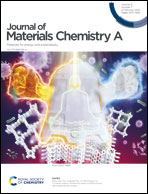An indium-induced-synthesis In0.17Ru0.83O2 nanoribbon as highly active electrocatalyst for oxygen evolution in acidic media at high current densities above 400 mA cm−2†
Abstract
Ruthenium dioxide-based electrocatalysts show the most potential in the acidic oxygen evolution reaction (OER). However, most of them show low current density, low mass activity and unsatisfactory stability under strong acidic and oxidative conditions. Herein, an indium-induced-synthesis InxRuyO2 nanoribbon electrocatalyst (named In0.17Ru0.83O2-350) was prepared, which achieves an overpotential of 177 mV at a current density of 10 mA cm−2 in 0.5 mol L−1 sulfuric acid. The mass activity is up to 1094.90 A gRu−1 at an overpotential of 300 mV, which is among the highest for ruthenium dioxide-based catalysts. Moreover, the catalyst displays a current density up to 400 mA cm−2, which is the highest current density in a small electrode system reported so far. It is found that indium doping can shift down the d-band center of Ru and reduce its work function, which can boost the electron transfer capacity between the catalyst surface and the reactants. Finite-element method simulations further demonstrate that the nanoribbon structure can not only expose more active sites to improve the mass activity of ruthenium and reaction current density, but also enhance the surface electric field intensity to boost the adsorption capacity of water molecules and the capacity of electron transfer, thereby accelerating the dynamics of OER.



 Please wait while we load your content...
Please wait while we load your content...